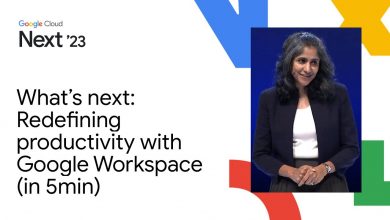The Future of Work with AI: Harnessing the AI Workforce Revolution and The Augmented Future
Ai, in the form of 'Copilots', is ushering in the next generation of enterprise technologies and will radically advance how it can augment and enhance modern work practices.
 In March of 2023 Microsoft shared this talk from Satya Nadella and Jared Spataro focused on how AI will power a whole new way of working for everyone.
In March of 2023 Microsoft shared this talk from Satya Nadella and Jared Spataro focused on how AI will power a whole new way of working for everyone.
Ai, in the form of ‘Copilots’, is ushering in the next generation of enterprise technologies and will radically advance how it can augment and enhance modern work practices.
The best way to understand how AI will transform office work is simply to apply the same principles that always have been for new business technology.
Since the very first computers and mainframes IT has been used to automate mundane tasks to free up people to work more creatively, and at a capacity and speed far beyond humans; and the central value of the Cloud has always been that it enables organizations of any size to tap into computing power on a shared basis that they couldn’t afford or have the skills to adopt directly in-house.
Ai represents the pinnacle of this. The ultimate evolution of massive, intelligent computing capability, made accessible to even the smallest of organizations via Cloud services like Zoom and Microsoft 365.
AI Can Now Attend Zoom Meetings for You: The Advent of the Copilot Era
With the rapid advancement of technology and the recent shift towards remote work, companies like Zoom have become instrumental in enabling seamless communication and collaboration, and so offer a unique perspective on the future of work and how it is shaping the way we work and collaborate.
As the Washington Post reported Ai can now attend Zoom meetings for you, just one example of the primary feature of this trend, the era of the ‘Copilot’. These are Ai agents that can intelligently automate various aspects of your office work.
The Zoom AI Companion is a Generative AI Digital Assistant designed to simplify and streamline daily tasks. By leveraging AI technology, it can understand and respond to user commands, providing real-time assistance and information. It can help users boost their productivity by automating repetitive tasks and providing quick access to information, valuable time and effort, and can even send and receive messages, make phone calls, and even facilitate video conferences.
Gary Sorrentino, Global CIO for Zoom, shares Four Predictions for the Future of Work, describing that organizations will embrace hybrid working as the norm, Ai will be applied to automate repetitive meeting tasks and similarly the technologies for virtual meetings will become both smarter and more transparent.
Microsoft Copilot
Similarly for Microsoft at the centre of this revolution is the Copilot concept and applications, which Microsoft CTO and President of AI Kevin Scott describes in this keynote talk: The Era of the AI Copilot. In this talk Microsoft describe Becoming an AI-Powered Organization with Microsoft Copilot.
Jared Spataro, Head of Microsoft’s Modern Work team, sets the scene in this Harvard Business Review interview, which looks at the future of work and the technologies that will get us there, and in this WSJ interview he discusses how the company is expanding access to OpenAI tools and the growing capabilities of ChatGPT.
In this video Microsoft introduces the 365 Copilot and in this one How It Works. There is one for each major product, such as Copilots for Teams Meetings, Outlook, Word, Excel, Powerpoint, Security and Power Apps.
The core ideal is one of intelligent work augmentation, where the copilot accelerates and magnifies the end result of what a person is trying to achieve, automating the mundane and enhancing the output.
For example imagine you missed an important meeting. You can use the Teams copilot to ‘follow’ the meeting, and be sent a summarized recap of what you missed. Consider the billions of other interactions like this one that office workers participate in, and how much of an overall productivity boost can be achieved with all of them enhanced this way.
The Digital Transformation of Work: Harnessing the AI Workforce Revolution and The Augmented Future
We can view this trend within an overall context of a broader digital transformation of work, that encompasses many other aspects including skills and culture.
Dion Hinchcliffe, a renowned expert in digital transformation and enterprise IT strategy, has shared valuable insights on the future of work, emphasizing that the digital transformation of work involves more than just implementing new technologies. It requires a fundamental shift in how organizations operate and how employees collaborate and communicate. The integration of digital tools and platforms enables greater flexibility, efficiency, and innovation in the workplace.
In the digital age, continuous learning and upskilling are essential for both organizations and individuals. Hinchcliffe emphasizes the need for organizations to invest in employee training programs that focus on digital skills and emerging technologies. Additionally, individuals must take ownership of their learning journey and actively seek opportunities to acquire new skills to remain relevant in the evolving job market.
Generative AI is poised to play a significant role in the future of work, according to Hinchcliffe. While it presents exciting opportunities, it is crucial to address the associated challenges and ensure responsible and ethical use. As this technology continues to evolve, it will reshape industries, empower workers, and unlock new possibilities.
Dr Mark van Rijmenam, a Strategic Futurist Digital Speaker, describes the overall theme as one of “The AI Workforce Revolution: The Augmented Future“. He explores various aspects of the of the ‘Augmented Workforce‘, how AI is augmenting human capabilities and enabling organizations to automate repetitive tasks, improve efficiency, and make data-driven decisions.
He also addresses the concerns and challenges associated with the AI workforce revolution, discussing issues such as job displacement, ethical considerations, and the need for upskilling and reskilling the workforce to adapt to the changing landscape. He emphasizes the importance of continuous learning, collaboration between humans and AI, and the need for ethical frameworks to guide AI implementation.
In this video Gerd Leonhard discusses the future of work and jobs in the era of artificial intelligence, exploring the potential impact of AI on various industries and provides insights into how the world might look like by 2030.
Leonhard discusses how AI is likely to replace certain jobs that involve repetitive tasks and data analysis, however he also emphasizes that AI will create new opportunities and jobs that require human skills such as creativity, empathy, and critical thinking. He suggests that individuals should focus on developing skills such as emotional intelligence, adaptability, and complex problem-solving, as these skills are less likely to be automated.
The AI-Powered Organization
In conclusion Mike Walsh, CEO of Tomorrow, a global consultancy on designing companies for the 21st century, explores Generative AI and the Future of Work, and in this talk a broader picture of Ai-enabled transformation overall.
Mike is a visionary in the field of The AI-Powered Organization, where he says ChatGPT and the rise of generative AI platforms are just the beginning of a much bigger algorithmic revolution that is set to reshape the future of work itself.
The future of work is bigger than AI chatbots, remote work, or the inevitable arrival of some kind of corporatized metaverse. True – technology is changing how we do things, but that is only part of the story.
There has always been a creative dynamic between new tools and the impact that has on the nature of work. Think about electricity. Over a century ago, this new energy source represented not only a new way of powering factories, but as Henry Ford would demonstrate with his moving assembly line innovation, a different way of thinking about designing work environments and processes as well.
We learned how to work in new ways during the pandemic. Now the question is, what do we want work to be?



